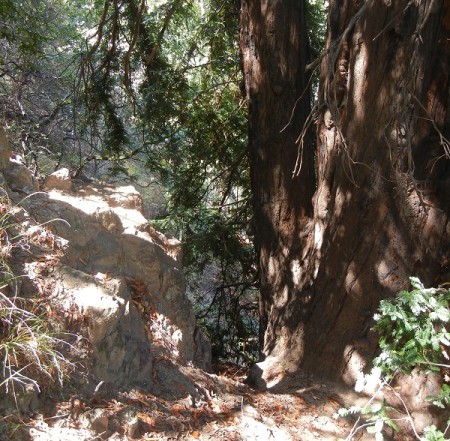I’ve been poking around Oakland’s edges lately. In southernmost East Oakland there’s not a lot of geologic history, but there are some big old trees, survivors of optimistic times, plus nice views of the hills and sky.
This is one of our largest and oldest jacarandas, on 90th Avenue. (There’s a comparable one on Pippin Street.) [Update: this tree is now gone.]
And here’s an even more exotic visitor, an Araucaria from the southern hemisphere (a monkey-puzzle tree, I think) in Sobrante Park.
On 105th Avenue, next to what appear to have been Oakland’s last commercial greenhouses, we have a big old lot where there used to be something but now there’s just a large generic tree. What has it survived?
The ground here is mapped as Bay mud, just past the seaward edge of the alluvial fan of San Leandro Creek. If the soil is still clean, it should be rich stuff.
Down at the end of 105th Avenue, hard by San Leandro Creek, is a cluster of venerable black walnuts.
Unlike the previous trees, these may well be natives. At least the species is right and the riparian (streamside) habitat is correct.
There are surely people in Oakland who remember the stories of these trees.
But I really wanted to talk about another old survivor tree, up in the hills on the south side of Horseshoe Canyon. In fact “Old Survivor” is its name. This last week I had the opportunity to visit it with a small group of people. It’s older than any human memory in these parts.
The group tended to refer to the tree as “the Grandfather Tree.” I thought “Grandmother” was a name just as good. But the DAR, in chiseling “Old Survivor” on this monument by Campus Drive at Carl Munck Elementary School, established priority. The age is subject to revision, though. The 1981 monument put the tree’s age at 425 years, but there’s no birth certificate for this baby. The tree was cored in the late 1960s, and its age at that time was estimated as 415–420 years. Let’s make 1550 its germinal year. So today it would be 465 years old. Here it is.
The Old Survivor is about 100 feet tall and has presence, especially when you think of it as the last old-growth redwood left in its East Bay stronghold. However, the loggers let it be because it was, and is, a scraggly, marginal specimen. Part of its uphill side is bare, fire-scarred wood. It’s flanked by two nuisance trunks that were less than marketable size in the 1850s redwood rush. The slope it sits on is more of a cliff, and had it been toppled it would have shattered.
The Old Survivor is rooted on Leona “rhyolite” rather than the moist mudstone of the Redwood Formation or Oakland Conglomerate that redwood prefers. But it’s fitting that Oakland’s oldest tree grows from Oakland’s oldest rock.
While the tree consists of a triple trunk, the central trunk stands above its siblings pretty well, if I can judge from the photos on oaklandwiki. I took a photo of its crown from the west side.
Old Survivor isn’t pretty, and it’s very hard to visit, but it’s still precious: the last bit of our forest primeval.








17 August 2015 at 7:21 am
Good to see such long time trees, especially after this morning’s “shake” – thanks.
22 August 2015 at 9:44 pm
That Araucaria is native to southern Argentina and Chile, mostly in the Andes but with a few stands in the Chilean coastal ranges.
28 May 2021 at 9:55 am
That’s some what true. 1 species of Araucaria is in southern Argentina and Chile., but not the species in the photo. That tree is an Araucaria bidwilli which is native to Australia’
28 May 2021 at 1:11 pm
There is also Araucaria angustifolia, which is native to Brazil.
8 June 2021 at 11:25 am
Pretty sure Olompali state historic park has an araucaria as well, in the formal garden: http://www.parks.ca.gov/?page_id=465
20 April 2022 at 12:48 pm
Nicely written.
Want to add that the Araucaria specimen might be a Bunya Bunya tree.
Difficult to tell the two apart, unless the Bunya has grown taller than any Monkey Puzzle will.
The single thing that makes me think this are the horizontal branches which more or less have whorls of leaves at their ends.
Anyhow..well done.
25 May 2022 at 10:40 am
I’m sorry to note that the jacaranda in this post has been cut down. It was on 90th Street, not 92nd, and I apologize for the error. Looks like it died the year after I took this picture.